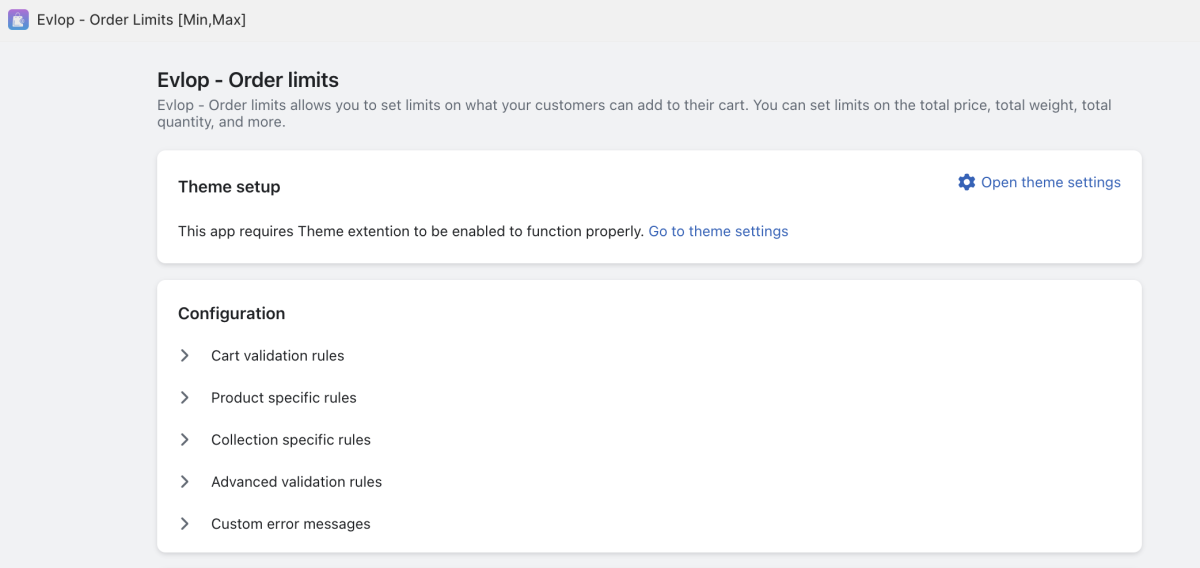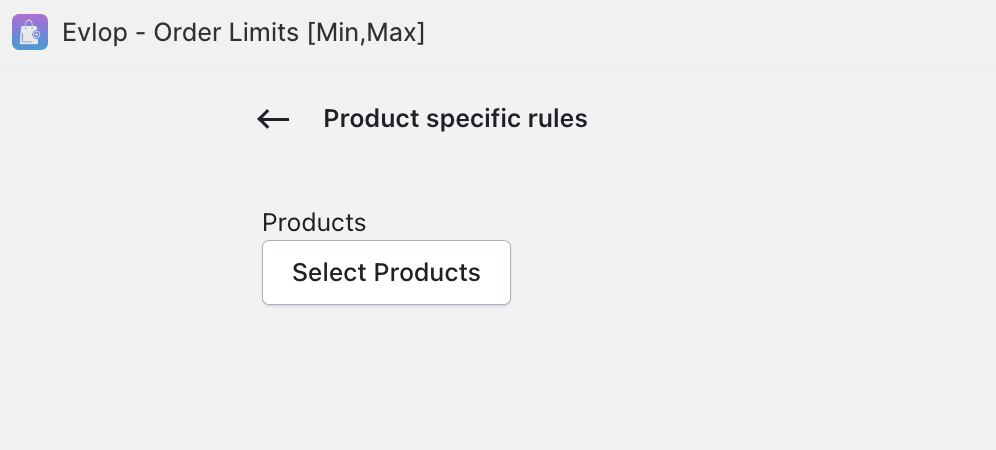To limit product purchases per customer, there are several effective solutions available through Shopify apps, custom coding, and workarounds.
This article covers various methods and scenarios, including limiting products per customer across multiple orders or per single checkout
1. Shopify: Limit Product Quantity Per Customer per Order with an app
To limit a product per customer we can use a Shopify app to help customise our store.
For the purpose of this article we will install and use the "Evlop ‑ Order Limits [Min,Max]" app which costs $5/month. (There are other apps available, but we like this for its liberal price)

One you have found and installed this app from the Shopify app store, head over to apps > "Evlop ‑ Order Limits [Min,Max]".

There is a Configuration tab which allows you to specify a variety of rules including cart validation rules, product specific rules as well as collection specific rules.
 Click on Product specific rules then select products to choose which products you would like to have a min and/or max quantity for:
Click on Product specific rules then select products to choose which products you would like to have a min and/or max quantity for:
 In our example we have selected the Blue Knitted Scarf.
In our example we have selected the Blue Knitted Scarf.
 We will update the max quantity for this product to 2 per customer. This enables us to limit products per customer.
We will update the max quantity for this product to 2 per customer. This enables us to limit products per customer.

Once you have made the required quantity changes, remember to click save. Also, note that you may need to enable the app via theme settings for the app to work properly.

To see these changes in effect, go to the product you have updated min or max quantities for and try to add more than the max product limit.
 You will notice in the example above, that when I add a quantity of 3, the buy button gets removed.
You will notice in the example above, that when I add a quantity of 3, the buy button gets removed.
I can still add to cart, however when I do this and then head to my cart, I see a message which states that "Quantity cannot be more than 2" which leaves me unable to checkout. This successfully allows me to limit product per customer.

2. Shopify: Limit Quantity Per Customer via Cart with an App
You can also implement cart rules to limit quantity per customer using similar steps as above, but this time we are going to select cart validation rules.
This option is perfect for those who want to limit the total number of products in the cart. For example, to allow customers to check out with a single product only.
 Here we are able to limit quantities per customer in a number of ways. First we can apply price rules so that there is a maximum or minimum total cart price.
Here we are able to limit quantities per customer in a number of ways. First we can apply price rules so that there is a maximum or minimum total cart price.
 We can also limit quantities by setting a minimum or maximum total quantity of all items in cart as well as a minimum or maximum quantity per item in cart.
We can also limit quantities by setting a minimum or maximum total quantity of all items in cart as well as a minimum or maximum quantity per item in cart.
I have a set a maximum quantity of 5 items in the cart.

Now when I try add more than 5 products to the cart, the cart automatically removes the 6th product thus bringing it down to 5 products again.
When I go to the cart page, and try to increase the quantity of a product to get it to 6 product, I see the following message: "Total quantity of items in cart cannot be more than 5".

Other Methods for Setting Limits on Shopify
While the Evlop app is an easy and cheap solution, there are other methods you can explore depending on your store’s needs:
3. Shopify: Limit Quantity Per Customer across multiple orders with MinMaxify or DC Order Limits app
Order-Based Limits: As other apps, MinMaxify allows you to set minimum and maximum limits per order. For example, you could limit customers to 5 units per checkout. However, it doesn’t support tracking across multiple orders.
Workaround for Customer-Based Limits: You can tag customers who have previously purchased items as “purchased before” and set a condition preventing them from buying again. To do that, you need to set-up a new Rule within the app and activate it only when the condition is met, aka the customer is tagged with a certain tag.
Another similar app that can help you with similar situations is called DC Order Limits app. You can create custom rules that apply limits to the entire cart. For instance, you can restrict customers from adding more than 1 of any item by setting the "Maximum Quantity" to 1. You can also apply rules for all customers or limit them to specific groups using customer tags.
4. Limit Quantity Per Shopify Collection, Customer, Order, or anything else with KOR Order Limit Quantity app
Lifetime Purchase Limits: This app allows you to set lifetime purchase limits per product. For example, you could restrict a customer to buying only 3 units of a product over their entire customer lifespan.
Customisable Options: Perfect for limiting quantities of digital products or limited-stock items with a large variety of limit options.
5. Limit Quantity on Shopify per Customer with a Discount Code Workaround
Using Discount Codes: Create a 0% discount code and limit its use to once per customer. The discount URL (e.g., www.yoursite.com/discount/yourdiscountcode?redirect=/products/yourproduct) acts as a soft limit, preventing customers from purchasing more than one product with the discount, however, you need to ensure that the discount is always applied.
6. Limit Quantity per Customer with Custom-Coded Solutions:
Modify the Shopify Theme: If you’re using a theme like Dawn, you can remove the quantity selector from product pages and use custom code to prevent customers from adding more than the allowed quantity to their cart.
Hire a Shopify Expert: For a more permanent and advanced solution, you could hire a Shopify developer to build a custom app or add functionality to track purchase history and enforce lifetime limits across multiple orders.
Why Implement Quantity or Product Limits?
Setting quantity limits per customer on Shopify is important for preventing stock abuse, ensuring fair distribution of limited products, and maintaining a positive customer experience. Whether you’re using an app like Evlop, a more advanced solution like MageComp, or a custom-coded workaround, it’s crucial to choose a method that suits your store’s specific needs.
Additionally, it's beneficial to communicate these limits clearly on product pages or during the checkout process to manage customer expectations effectively.



